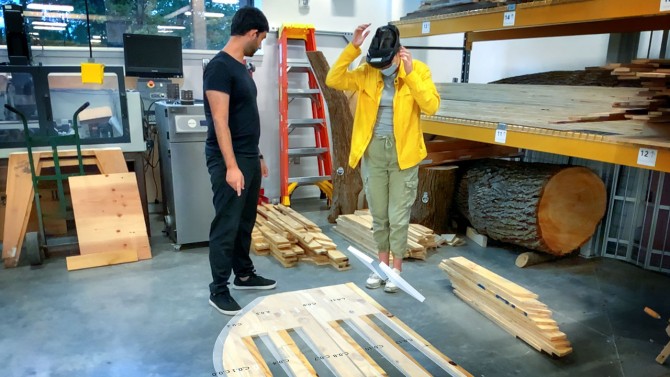The HoloWall installation upcycles salvaged waste wood from a collapsed barn in the region.
Arts Quad installation upcycles wood with mixed reality
By James Dean
A curiously shaped wall featuring upcycled barn wood first appeared on the Arts Quad as a hologram.
That movable 3D rendering, projected through a headset, enabled designer Leslie Lok, assistant professor in the College of Architecture, Art and Planning (AAP), to select the optimal site for the structure’s five branching panels in relation to nearby trees, and based on the views through gaps in its latticed planks.
And it was the next step in her Rural-Urban Building Innovation (RUBI) Lab’s research into how augmented- and mixed-reality technology could help process nonuniform waste wood into a useful building material – without costly tools or highly skilled labor.
Earlier, computer-generated instructions had guided the research team in AAP’s wood shop as they measured, cut and glued together (laminated) a mix of plywood and the century-old wood salvaged from a collapsed barn in Slaterville Springs, not far from Cornell’s Ithaca campus.
Lok dubbed the temporary installation “HoloWall,” referencing the digital process central to its design and assembly as well as the hollow core embedded within the cross-laminated timber structure, which reduced by roughly a third the amount of material used, promoting sustainability.
“Everything is tied to the technology,” Lok said. “Technology enables the use of this resource and the customization of the design, and makes it accessible to local labor, both expert and nonexpert.”
Situated between White and McGraw halls and overlooking the valley to the west, the design also references traditional windbreaking shelters utilized in agricultural landscapes to protect livestock and buildings.
Wind analyses informed HoloWall’s placement and a form that Lok said observers might find “curious” at first glance. The west-facing panels are angled and curved to dissipate prevailing winds. The laminated wooden planks and boards are densest where the wall is anchored to the ground, but spaced apart at increasing intervals as the wall seems to lift upward to a height of six feet. The resulting voids reduce pressure build-up behind the wall, remove mass from the structure and introduce views.
On the east-facing side, the more thickly layered lower sections form seats providing a sheltered and socially distanced space for visitors to gather on the Arts Quad.
Structurally and architecturally, Lok said HoloWall investigates an alternative to cross-laminated timber, or CLT – a popular building material produced in solid panels – to experiment with a hollow-core construction.
“There are possibilities to remove materials strategically for structural reasons and for architectural effect,” she said.
The salvaged lumber, meanwhile, is an example of a regional resource that is plentiful but whose nonuniform dimensions make it challenging to process as a building material, Lok said – one reason why wood accounts for 10% of all material deposited in landfills.
Lok’s Ashen Cabin, designed with Sasa Zivkovic, assistant professor in AAP and co-principal with Lok of the HANNAH Design Office, similarly explored upcycling wood from ash trees damaged by the emerald ash borer.
But whereas the cabin project relied on advanced robotic tools that are not widely available, HoloWall was made entirely manually, and without drawings.
Because the barn wood started in all different sizes, the design team scanned each member and developed digital scripts that determined the maximum usable area. Then they assigned custom digital shapes to each board, generating a sort of virtual assembly line for fabricators to follow when marking and cutting.
Lok said the process demonstrated opportunities for more affordable and sustainable development on urban fringes, including in fast-growing parts of China, a focus of her research. The goal is to take advantage of local resources not commonly used in building and enable their processing without expensive machining equipment and expertise. The technology also enables “mass customization” that would be costly with traditional tools and methods, she said.
Some of the students on the fabrication team had no prior experience using a mixed-reality headset and software before they began matching raw boards to digital stencils or applying glue to the wood in custom patterns.
“This is a technology that could be democratized to a larger audience in different contexts, engaging nonexpert users,” Lok said. “It opens up access.”
Lok plans to submit a research paper to a peer-reviewed publication about HoloWall, which is expected to remain on display through April. The project was funded in part by a Cornell Council for the Arts faculty grant, AAP’s Aref and Manon Lahham Excellence Fund for Sustainability and the Department of Architecture.
Architecture students supporting the project were led by Nina Koscica ’21 and included Sahil Adnan, M.Arch ’24; Bushra Aumir ’22; Jiyoon Bae, M.S. ’22; Sahir Choudhary ’21; and Asbiel Samaniego, M.S. ’22. Lok also thanked AAP’s wood shop staff.
Media Contact
Get Cornell news delivered right to your inbox.
Subscribe


